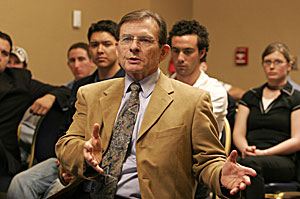 |
|
JACOB KONST/Arizona Daily Wildcat
|
President Peter Likins addressed the ASUA Senate meeting Wednesday, discussing topics of tuition increases, focused excellence and diversity. Likins and 3 additional cabinet members plan to retire July 1, 2006.
|
|
|
By Natasha Bhuyan
Arizona Daily Wildcat
Friday, February 11, 2005
Print this
Search for new UA president to kick off in May
When President Peter Likins retires in 2006, he's not going alone, as three members of his cabinet will also be handing over the reins. However, student leaders have high expectations for the next wave of administration.
Although they have not officially announced their retirement, Saundra Taylor, senior vice president for campus life, and Joel Valdez, senior vice president for business affairs, will be retiring in 2006, said Likins. Richard Powell, vice president for research, graduate studies and economic development, will retire this summer.
"There will be a major change in leadership at that time," Likins said.
Likins, who will be 70 years old when he retires in 2006, said he announced his retirement in 2003 so the campus would have time to prepare for the transition, but students say they are still concerned about the change.
The students' biggest fear is a new team of administrators who are not as committed to student concerns as the current cabinet, said Student Regent Ben Graff.
Graff said in 2000, when he met with student government officials from universities across the Pacific 10 Conference, other students were shocked to learn the Associated Students of the University of Arizona leaders have one-on-one meetings with Likins on a monthly basis.
"Ninety percent of the universities were amazed by something that seems so part of the communication here at the UA," Graff said.
Doug Hartz, ASUA president in 2002-03 and a second-year medical student at the UA, said despite student-administration conflicts, Likins' cabinet respects student opinions, which he hopes will continue with the next wave of leadership.
"Whenever I've seen them with NAU and ASU (administrators), I was always proud of the fact that our administration seemed to be the best: the most professional, articulate, exemplary leadership," Hartz said. "And while we didn't always agree, a testament to their character was they were always willing to sit down, talk things over and listen to another perspective."
Taylor, a 14-year veteran of her position, said Likins' cabinet is proficient because they look at the university as a whole rather than promote individual agendas, and she hopes the trend will remain as the new administrators take over.
However, finding a replacement for the president will be a rigorous process, which could take more than six months, said Likins, who was interviewed for 15 hours before he was appointed UA president in 1997.
In May, the Arizona Board of Regents will create a presidential search committee, chaired by a regent and made up of students, faculty, Tucson community members and UA representatives, Likins said.
The committee will define their expectations for president, identify finalists, interview candidates and recommend a new president for the regents to approve.
Juan Garcia, vice provost of academic affairs, said although he does not know the search committee's goals, the UA community has high expectations for the next president.
"You have to be an effective communicator, have a deep understanding of the complexity of a university this size, you should believe in shared governance, understand the academic mission of the university and have strong ethics," Garcia said.
Provost George Davis said he admires Likins' method of describing decision-making in a shared governance environment: Consult others before the decision is made, make the decision and then explain the decision. The university's high value on shared governance leads to more informed decisions, Davis said.
Still, picking a new president means finding someone who "walks on water, leaps tall buildings in a single bound," Likins joked. "It's one of the most difficult jobs that are out there -– the primary requirement is stamina, seven days a week, 18 hours a day," Likins said.
Linda Stapleton, executive assistant to the president, said Likins' typical day includes an early morning meeting with administrators, a teleconference call with the regents, communication with the governor's office, meetings with diversity groups, Faculty Senate, deans, students, the mayor, business executives, lunch with a donor, testifying on behalf of the UA at the State Legislature in Phoenix, attending budget hearings and serving on national boards, such as the NCAA Division I Board of Directors.
At night and on weekends, Likins does paperwork from home, while remaining accessible by responding to e-mails from students and returning phone calls to the press, Stapleton said.
On top of a demanding schedule, cabinet members said the new administrators would be faced with an onslaught of delicate issues when they take office, including budget cuts, improving graduation rates, increasing diversity and the expansion of the UA's College of Medicine, which will open its Phoenix campus the same day Likins retires, July 1, 2006.
Powell said while funding will remain an important issue, his successor must also grasp the UA's increasing leadership role in Tucson's economic development.
After retiring, Taylor said she will cheer on the UA as a sport enthusiast, while Powell said he will spend more time with his grandchildren. Likins said he plans to work hard until his last minute as president, then will remain active in the community, minus golfing.
"The last time I was on a golf course I was carrying somebody else's bags," Likins said.
